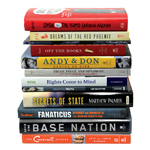PICK OF THE SYLLABUS: A World Made New
Stephen Angle, Associate Professor of Philosophy, selects A World Made New: Eleanor Roosevelt and the Universal Declaration of Human Rights by Mary Ann Glendon
Thriller, biography, learned analysis, and polemic—A World Made New is all these and more. Mary Ann Glendon takes us back to a brief period of possibility after the end of World War II and before the Cold War had fully taken hold, telling the stories of a remarkable group of men and women who struggled to define the ideals of a new world. Eleanor Roosevelt plays an important and too–little–remembered role in the drama, but this is really an ensemble cast: Glendon’s story is neither “America Made New” nor “America Triumphant.” Roosevelt and America sometimes play a leading role, sometimes learn from others, and sometimes obstruct. So, too, for other nations and their representatives. Beyond these particular people and their particular moment in history, though, this is the story of a document claiming universal relevance—a relevance that Glendon endeavors to defend by appealing, in part, to the very diversity of the particular people and nations whose efforts, arguments, and vision made the Universal Declaration of Human Rights (UDHR) into a reality.
A World Made New is not the definitive, scholarly account of the genesis of the UDHR; it is not an authoritative biography of Eleanor Roosevelt; and it is not a detailed philosophical argument for the universality of human rights. By drawing together elements of each, Glendon has written an important book for an age in which the origins and ideals of the UDHR are too little known. For students in my Human Rights Across Cultures class, A World Made New offered an opportunity for synthesis, reflection, and a brief break from more conventional scholarly writing and analysis. For readers no longer in college, it is a book that engages from the beginning, while all throughout it teaches and stimulates reflection on the role of human rights—and of efforts to reach international consensus—in our world today.
A central and instructive theme of Glendon’s book is the efforts taken by the crafters of the UDHR to work for true cross–cultural consensus. Roosevelt wrote of P.C. Chang, a Chinese diplomat who was one of those most responsible for the final text—along with Charles Malik of Lebanon, John Humphrey of Canada, Rene Cassin of France, and, of course, Roosevelt—that “Dr. Chang was a pluralist and held forth in charming fashion on the proposition that there is more than one kind of ultimate reality. The Declaration, he said, should reflect more than simply Western ideas.” Put into more political terms, this fit well with a sentiment that Roosevelt shared with her husband; as FDR had put it in 1943, “The doctrine that the strong should dominate the weak is the doctrine of our enemies, and we reject it.”
The UDHR was passed unanimously, albeit with eight abstentions, by the United Nations General Assembly on Dec. 10, 1948. Many of its proponents had also hoped to be able to produce a more binding Covenant, which would be ratified by each member nation individually, and thus have some ability to enforce compliance. The opportunity for constructive international conversations about shared norms had passed, however, overtaken by the Cold War. A month after the UDHR’s passage, the president of the American Bar Association derided it as a manifesto on “pink paper” whose adoption would “promote state socialism, if not communism, around the world.” It was not until the mid–1960s that two International Covenants on human rights were established; one of them, the Covenant on Economic, Social, and Cultural Rights, has yet to be ratified by the United States. For all its public support for many of the values enshrined in the UDHR, and despite Eleanor Roosevelt’s leading role in the document’s creation, another lesson we can take from Glendon’s book is how hard it has been for the United States to compromise, to participate in dialogue, rather than to dictate. Roosevelt understood this: just before the final vote on the UDHR, she noted to a friend, “We will have trouble at home for it can’t be a U.S. document & get by with 58 nations, & at home that is hard to understand.” Perhaps the most important contribution of A World Made New is to help us to understand what it means to live in a shared world.

